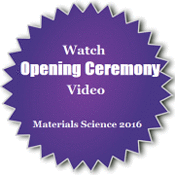
Isaac D Adebiyi
Vaal University of Technology, South Africa
Title: Microstructure and surface properties of Ti-6Al-4V cold spray coated with SiC-based cermet
Biography
Biography: Isaac D Adebiyi
Abstract
Statement of the Problem: A more ubiquitous application of Ti-6Al-4V in the aerospace industry has been hindered by its poor set of surface properties. The cold spray coating (CSC) process is suitable for improvements in the surface properties but the process is very complex, and highly dependent and sensitive to small changes in its many process parameters. Moreover, the CSC is also very selective of the choice of powder materials. The choice is not only based on application requirements but also on plastic deformability of the powder. Methodology & Theoretical Orientation: This investigation presents a mathematical identification of the optimum process parameters by using a constitutive equation to solve the continuity, momentum and the energy equations governing the flow of fluid through the low-pressure cold spray nozzle. A CFD analysis is performed to determine the input temperature that will yield the calculated velocity by using the meshing tool of Solidworks to analyze the distribution of velocity, temperature, and pressure in the cold spray nozzle and predict their exit values. The optimum parameters were used to deposit a SiC-based cermet on Ti-6Al-4V. The microstructure and phase evolution in the coatings were studied; porosity was measured using ImageJ analysis software; the hardness was measured using Vickers hardness tester; adhesion test was performed according to ASTM C633-1; and the dry sliding wear behaviour was studied in a ball-on-disc configuration using a load of 25 N at a frequency of 5 Hz. Findings: Results show that the initial phases in the feedstock powder were retained in the coatings. No detrimental phase transformation, decomposition and/or decarburization of the SiC. There was peak shift between the phases in the feedstock powder and that of the coatings. This is traced to impact-induced micro-straining, amorphization and grain refinement. A good adhesion strength, and improvements in hardness and wear resistance were obtained in the coated samples although with a higher coefficient of friction which is traceable to higher strength and lack of micro films in the coating. Conclusion & Significance: The improved surface properties of the coating will lengthen the lifespan of the expensive Ti-6Al-4V alloy, leading to significant cost savings for the aerospace industry.


